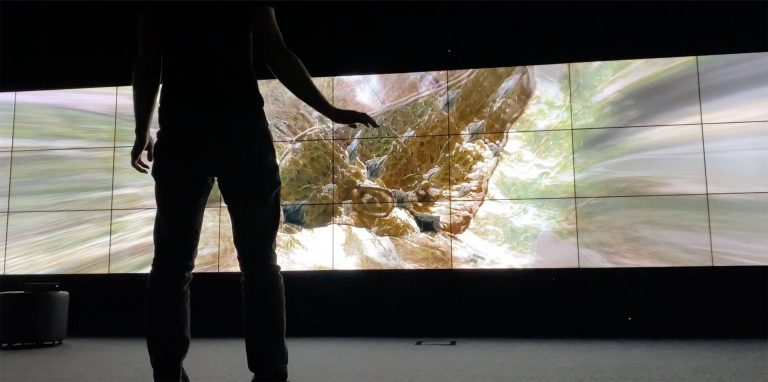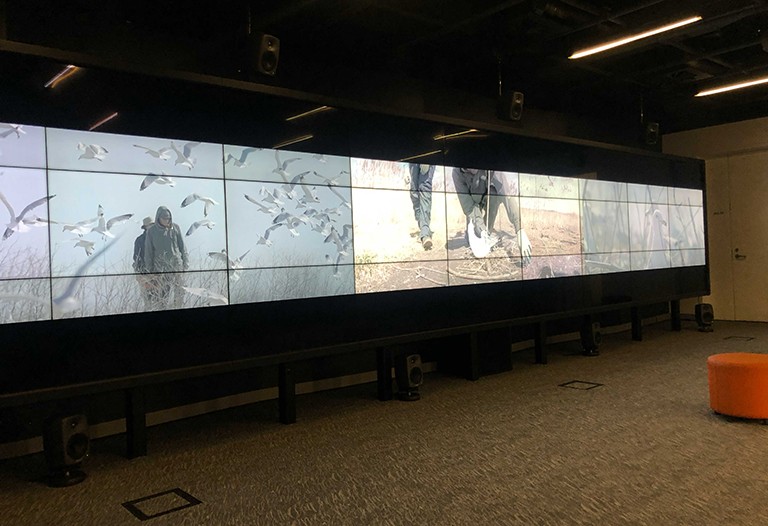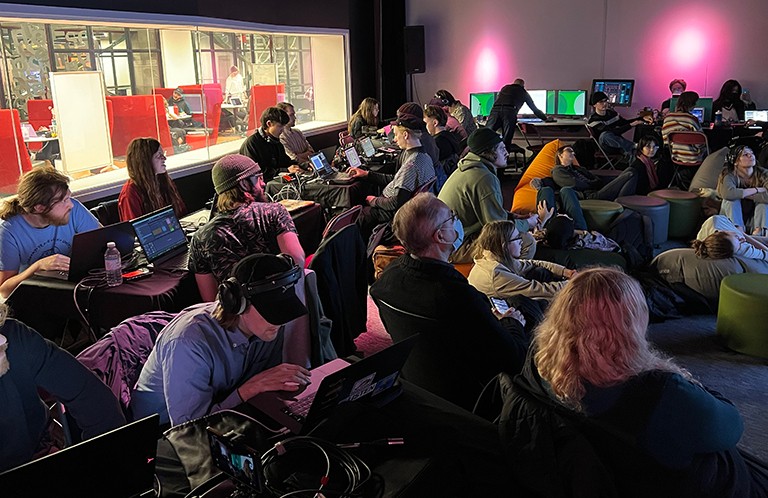Concordia Library’s Visualization Studio pushes the boundaries of immersive and interactive technologies

The Visualization Studio at Concordia’s Webster Library has been serving students and faculty since its official unveiling in late 2017. The studio was a key addition to the Webster Library’s transformation project, inaugurated on March 23, 2018.
Since then, the studio has significantly enhanced the university community’s digital capabilities, offering cutting-edge digital tools in collaborative learning spaces.
Limitless opportunities for research and collaboration
The studio’s innovative space offers immersive visualizations and analytics to support learning, teaching and research in all disciplines. It also serves as a teaching and presentation area for classes, seminars, conferences, thesis defences and showcases for industry partners.
The Webster Library Visualization Studio makes it possible for Concordians to advance their digital capabilities through the integration and use of immersive and interactive technologies and tools in their scholarly and creative activities,” says David Somiah Clark, BFA 16, the Library’s immersive technology lead.
“Immersive and embodied experiences can reveal new information. Faculty and students from all disciplines are leveraging the studio’s capabilities for research, to develop and showcase projects and for teaching and learning,” adds Clark, who manages the studio.
“We work closely with studio users. These collaborations help us steer the studio’s technology and services to support the evolving needs of faculty and students. We are continually pushing the space’s capabilities while developing pathways to ensure that the technology is accessible to faculty and students from all disciplines and backgrounds.”
 "As the Gull Flies" – photo from Elizabeth Miller's immersive film/installation.
"As the Gull Flies" – photo from Elizabeth Miller's immersive film/installation.
Exploring the studio’s ‘immersive potential’
“Our community of users has developed some incredible projects. They often involve multidisciplinary collaborations between faculty and students from different faculties and departments,” Clark notes.
One of these projects used the Visualization Studio as a development space. Elizabeth Miller, a documentary maker, scholar and professor in Concordia’s Department of Communication Studies, is the producer and director of As the Gull Flies. This immersive educational film and installation was designed for a distinctive 360-degree spherical screen at the Montreal Biosphère.
Miller notes that the Visualization Studio became an ideal rehearsal space for the film’s screening. “The studio permitted us to have a better sense of the immersive potential of the material we were working with,” she says.
“We hosted a rough-cut screening in the Visualization Studio so that we could invite the museum curators and other collaborators to see a work in progress. Not only did we get great feedback, but it was an ideal way to forge a new community — to bring professors, artists, students, curators to the Visualization Studio for a meaningful exchange.”
 "Interstellar Sanctuaries" performed by the Concordia Laptop Orchestra (CLOrk) on March 23, 2023.
"Interstellar Sanctuaries" performed by the Concordia Laptop Orchestra (CLOrk) on March 23, 2023.
Hitting high notes in musical and spatial performances
The Department of Music’s Ricardo Dal Farra, a professor, and Eldad Tsabary, chair and associate professor, have been exposing their students to the studio’s particular environment and interactive technological resources. Dal Farra describes the studio as a fantastic resource where he brings his advanced electroacoustic music composition students.
“The Visualization Studio allows my students to immerse themselves creatively in an environment that facilitates perceptual and physical interaction with the audiovisual world that makes up the space,” he says.
“The 27 interactive screens and the multi-channel spatialized audio sound system with sophisticated software, motion sensors, and VR devices create an excellent experimentation environment for my students’ research-creation work.”
The Concordia Laptop Orchestra (CLOrk) — created by Tsabary in collaboration with his students — has greatly benefitted from the studio’s space. CLOrk uses it for innovative performances that have emphasized audience interaction and democratic setups for live spatial performances.
“An increasing number of our students, both undergraduate and graduate, are turning to the Visualization Studio for their research-creation projects, VR installations and various explorations into technological performance and creation,” Tsabary reports.
New perspectives for digital artists
Tim Murray-Browne is a digital interaction artist, engineer and coder based between Montreal, Glasgow and London. Over the summer terms, he used the studio to continue work on an interactive installation, Self Absorbed, during a residency at Concordia’s Milieux Institute for Arts, Culture and Technology.
“The Visualization Studio gave me a whole new perspective on an artwork I was developing. I got people in there and completely immersed them in AI imagery I was generating live in response to their movements,” he says.
“The scale amplified the experience. It also gave me a sense of alternative presentation formats I’d never previously had the chance to try out,” Murray-Browne adds.
“Usually, you only get to try out this kind of gear once a work is finished and being installed on site. Rather than being overly locked down, David had set up the gear in an incredibly flexible way,” he says about Clark.
“He was genuinely passionate for it to be used to its full extent. And he understood that that may be used in ways beyond what he had envisaged when putting the space together.”
An expansive space for expansive ideas
Kasey Pocius, BFA 20, a graduate of Concordia’s Electroacoustic Studies program, echoes the enriching experience.
“The studio provided a unique space to work on audiovisual pieces with spatial audio. It’s rare to have a studio that can provide high-quality facilities for both, while also being flexible to the needs of its users in terms of both input devices and software,” they say.
“I was able to explore several facets of my work, such as performing with Digital Musical Instruments (DMIs), live coding audio and video, and working in ambisonics. Ambisonics is an audio format that allows me to easily transport immersive compositions between spaces,” Pocius adds.
“Rarely did I have to downscale my artistic interests to fit the space. The incredibly flexible nature of the space and the willingness of the staff to work with me through the process allowed me to solve most technical challenges I encountered.”
Find out more about Concordia Library’s Visualization Studio.
Learn more about Concordia’s Department of Music.


